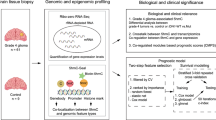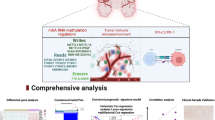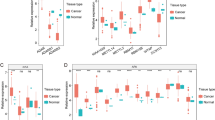Abstract
Glioblastoma (GBM) emerges as the most common malignant brain tumor. Histone modifications, as an epigenetic regulatory mechanism of gene expression, are closely associated with malignant tumors. Gene set related to histone modification was extracted from the MSigDB database, and scored by the function of AddModuleScore. Pearson correlation analysis was utilized using the “rcorr” function of “Hmisc” R package. Genes were screened out using the LASSO Cox analysis. TCGA-GBM and CGGA_array_301 cohorts were employed for constructing model and validation. We calculated immune infiltration scores using microenvironment cell populations counter (MCPcounter), single-sample gene set enrichment analysis (ssGSEA), and xCell algorithms. U87-MG and CHG-5 cell lines were utilized to evaluate expression level of TMEM176A by western blot (WB). Transwell, EDU, colony formation analysis (CFA), and CKK-8 assays were conducted to investigate cell proliferation and migration rate. The malignant cells in GBM patients exhibited notable activation in the TGF-β and hypoxia pathway. Histone modifications were associated with adhesion and neuron development in GBM. We identified a model with five significant genes, namely NBEAL1, AEBP1, TMEM176A, FASTK, and CD81, with prognostic efficacy. Additionally, we observed increased infiltration of T cells and CD8+ T cells in the high-risk (HR) group. 5-Fluorouracil_1073 and Taselisib_1561 were predicted as potential treatment options for GBM patients, while ABT737_1910 and Wnt_C59-1622 exhibited superior response in GBM patients of the HR group. A spike in the TP53 mutation rate was observed in the HR group. TMEM176A played a role in regulating cell proliferation and migration in vitro. We presented a novel prognostic model for patients with GBM, based on histone modification-related genes. In addition, we identified the crucial role of the TMEM176A in the regulation of GBM carcinogenic phenotypes for the first time.









Similar content being viewed by others
Data availability
All original data can be obtained from Yunhui Wang.
References
Bush NAO, Hervey-Jumper SL, Berger MSJWN (2019) Management of glioblastoma, present and future. World Neurosurg 131:328–338
Chen W, Wang F, Zhang J, Li C, Hong L (2022) LINC01087 indicates a poor prognosis of glioma patients with preoperative MRI. Funct Integr Genomics 22(1):55–64
Cheng J, Fan YQ, Liu BH, Zhou H, Wang JM, Chen QX (2020) ACSL4 suppresses glioma cells proliferation via activating ferroptosis. Oncol Rep 43(1):147–158
Codrici E, Popescu ID, Tanase C, Enciu AM (2022) Friends with benefits: chemokines, glioblastoma-associated microglia/macrophages, and tumor microenvironment. Int J Mol Sci 23(5):2509
Daroqui MC, Vazquez P, de Kier B, Joffé E, Bakin AV, Puricelli LI (2012) TGF-β autocrine pathway and MAPK signaling promote cell invasiveness and in vivo mammary adenocarcinoma tumor progression. Oncol Rep 28(2):567–575
Derynck R, Budi EHJSS (2019) Specificity, versatility, and control of TGF-β family signaling. Sci Signal 12(570):eaav5183
Esemen Y, Awan M, Parwez R, Baig A, Rahman S, Masala I, Franchini S, Giakoumettis D (2022) Molecular pathogenesis of glioblastoma in adults and future perspectives: a systematic review. Int J Mol Sci 23(5):2607
Guo K, Song L, Chang J, Cao P, Liu Q (2020) AEBP1 promotes glioblastoma progression and activates the classical NF-κB pathway. Behav Neurol 2020:8890452
Guo L, Zhang Y, Zhang L, Huang F, Li J, Wang SJTB (2016) MicroRNAs, TGF-β signaling, and the inflammatory microenvironment in cancer. Tumour Biol 37:115–125
Guo S, Liu X, Zhang J, Huang Z, Ye P, Shi J, Stalin A, Wu C, Lu S, Zhang F, Gao Y, Jin Z, Tao X, Huang J, Zhai Y, Shi R, Guo F, Zhou W, Wu J (2023) Integrated analysis of single-cell RNA-seq and bulk RNA-seq unravels T cell-related prognostic risk model and tumor immune microenvironment modulation in triple-negative breast cancer. Comput. Biol Med 161:107066
He L, Deng HJN (2017) Decreased expression of MS4A12 inhibits differentiation and predicts early stage survival in colon cancer. Neoplasma 64(1):65–73
Hong D, Zang A, Wang Z, Yang L, Ren G, Zhang C, Zhang L, Hou W, Wei Y (2022) Elevation of microRNA-365 impedes malignant behaviors of gastric cancer cells by inhibiting PAX6. Funct Integr Genomics 22(5):825–834
Howley BV, Howe PH (2019) TGF-beta signaling in cancer: post-transcriptional regulation of EMT via hnRNP E1. Cytokine 118:19–26
Jan CI, Tsai WC, Harn HJ, Shyu WC, Liu MC, Lu HM, Chiu SC, Cho DY (2018) Predictors of response to autologous dendritic cell therapy in glioblastoma multiforme. Front Immunol 9:727
Kunadis E, Lakiotaki E, Korkolopoulou P, Piperi C (2021) Targeting post-translational histone modifying enzymes in glioblastoma. Pharmacol Ther 220:107721
Li H, Yang W, Zhang M, He T, Zhou FJGH, Hu L, Guo M (2021) Methylation of TMEM176A, a key ERK signaling regulator, is a novel synthetic lethality marker of ATM inhibitors in human lung cancer. Epigenomics 13(17):1403–1419
Lu Y, Li L, Chen L, Gao Y, Chen X, Cao Y (2020) TRIB3 confers glioma cell stemness via interacting with β-catenin. Environ Toxicol 35(6):697–706
Majdalawieh AF, Massri M, Ro HS (2020) AEBP1 is a novel oncogene: mechanisms of action and signaling pathways. J Oncol 2020:8097872
Mattiola I, Mantovani A, Locati MJTII (2021) The tetraspan MS4A family in homeostasis, immunity, and disease. Trends Immunol 42(9):764–781
McAnena P, Brown JA, Kerin MJ (2017) Circulating nucleosomes and nucleosome modifications as biomarkers in cancer. Cancers 9(1):5
Melincovici CS, Boşca AB, Şuşman S, Mărginean M, Mihu C, Istrate M, Moldovan IM, Roman AL, Mihu CM (2018) Vascular endothelial growth factor (VEGF) — key factor in normal and pathological angiogenesis. Romanian Jo Morphol Embryol = Rev Roum de Morphol Embryol 59(2):455–467
Oike T, Suzuki Y, Sugawara K, Shirai K, Noda SE, Tamaki T, Nagaishi M, Yokoo H, Nakazato Y, Nakano T (2013) Radiotherapy plus concomitant adjuvant temozolomide for glioblastoma: Japanese mono-institutional results. PLoS One 8(11):e78943
Pathak P, Jha P, Purkait S, Sharma V, Suri V, Sharma MC, Faruq M, Suri A, Sarkar C (2015) Altered global histone-trimethylation code and H3F3A-ATRX mutation in pediatric GBM. J Neuro-Oncol 121(3):489–497
Ren R, Wang H, Xie L, Muthupandian S, Yang X (2023) Identify potential urine biomarkers for bladder cancer prognosis using NGS data analysis and experimental validation. Appl Biochem Biotechnol 195(5):2947–2964
Roura AJ, Szadkowska P, Poleszak K, Dabrowski MJ, Ellert-Miklaszewska A, Wojnicki K, Ciechomska IA, Stepniak K, Kaminska B, Wojtas B (2023) Regulatory networks driving expression of genes critical for glioblastoma are controlled by the transcription factor c-Jun and the pre-existing epigenetic modifications. Clin Epigenetics 15(1):29
Shah U, Morrison TJJOTNCCN (2013) A review of the symptomatic management of malignant gliomas in adults. J Natl Compr Canc Netw 11(4):424–9
Sun L, Zhang H, Gao P (2022) Metabolic reprogramming and epigenetic modifications on the path to cancer. Protein Cell 13(12):877–919
Sun L, Zhang Y, Zhang C (2018) Distinct expression and prognostic value of MS4A in gastric cancer. Open Med (Warsaw, Poland) 13:178–188
Sung H, Ferlay J, Siegel RL, Laversanne M, Soerjomataram I, Jemal A, Bray F (2021) Global Cancer Statistics 2020: GLOBOCAN estimates of incidence and mortality worldwide for 36 cancers in 185 countries. CA Cancer J Clin 71(3):209–249
Suriyamurthy S, Baker D, Ten Dijke P, Iyengar PVJC (2019) Epigenetic reprogramming of TGF-β signaling in breast cancer. Cancers (Basel) 11(5):726
Wang J, Li S, Guo Y, Zhao C, Chen Y, Ning W, Yang J, Zhang H (2023) Cuproptosis-related gene SLC31A1 expression correlates with the prognosis and tumor immune microenvironment in glioma. Funct Integr Genomics 23(3):279
Wang Y, Zhang Y, Herman JG, Linghu E, Guo M (2017) Epigenetic silencing of TMEM176A promotes esophageal squamous cell cancer development. Oncotarget 8(41):70035–70048
Watanabe T (2021) The tumor microenvironment in follicular lymphoma: its pro-malignancy role with therapeutic potential. Int J Mol Sci 22(10):5352
Yan X, Feng L, Xu Z, Chen W, Yan H, Wu P, Ding C, Zhu X, Lu Y (2023) Histone acetylation gene-based biomarkers as novel markers of the immune microenvironment in glioblastoma. J Gene Med 25:e3511
Yang W, Xiu Z, He Y, Huang W, Li Y, Sun T (2020) Bip inhibition in glioma stem cells promotes radiation-induced immunogenic cell death. Cell Death Dis 11(9):786
Zaib S, Rana N, Khan I (2022) Histone modifications and their role in epigenetics of cancer. Curr Med Chem 29(14):2399–2411
Zeng Y, Tan P, Ren C, Gao L, Chen Y, Hu S, Tang N, Chen C, Du S (2022) Comprehensive analysis of expression and prognostic value of MS4As in glioma. Front Genet 13:795844
Zhou H, Ke J, Liu C, Zhu M, Xiao B, Wang Q, Hou R, Zheng Y, Wu Y, Zhou X, Chen X, Pan H (2023) Potential prognostic and immunotherapeutic value of calponin 1: a pan-cancer analysis. Front Pharmacol 14:1184250
Acknowledgements
Thanks to all the researchers who participated in this study.
Funding
The study was funded by Huzhou City Natural Science Foundation of China (Grants No. 2022YZ55).
Author information
Authors and Affiliations
Contributions
YW participated in literature collection, thought construction, and article writing. LKJ and CJ participated in data collection, and FW is responsible for the full text data.
Corresponding author
Ethics declarations
Ethical approval
Not applicable.
Conflict of interest
The authors declare no competing interests.
Additional information
Publisher’s Note
Springer Nature remains neutral with regard to jurisdictional claims in published maps and institutional affiliations.
Rights and permissions
Springer Nature or its licensor (e.g. a society or other partner) holds exclusive rights to this article under a publishing agreement with the author(s) or other rightsholder(s); author self-archiving of the accepted manuscript version of this article is solely governed by the terms of such publishing agreement and applicable law.
About this article
Cite this article
Wang, Y., Ji, L., Ji, C. et al. Multi-omics approaches establishing histone modification based prognostic model in glioma patients and further verification of the carcinogenesis mechanism. Funct Integr Genomics 23, 307 (2023). https://doi.org/10.1007/s10142-023-01229-3
Received:
Revised:
Accepted:
Published:
DOI: https://doi.org/10.1007/s10142-023-01229-3




